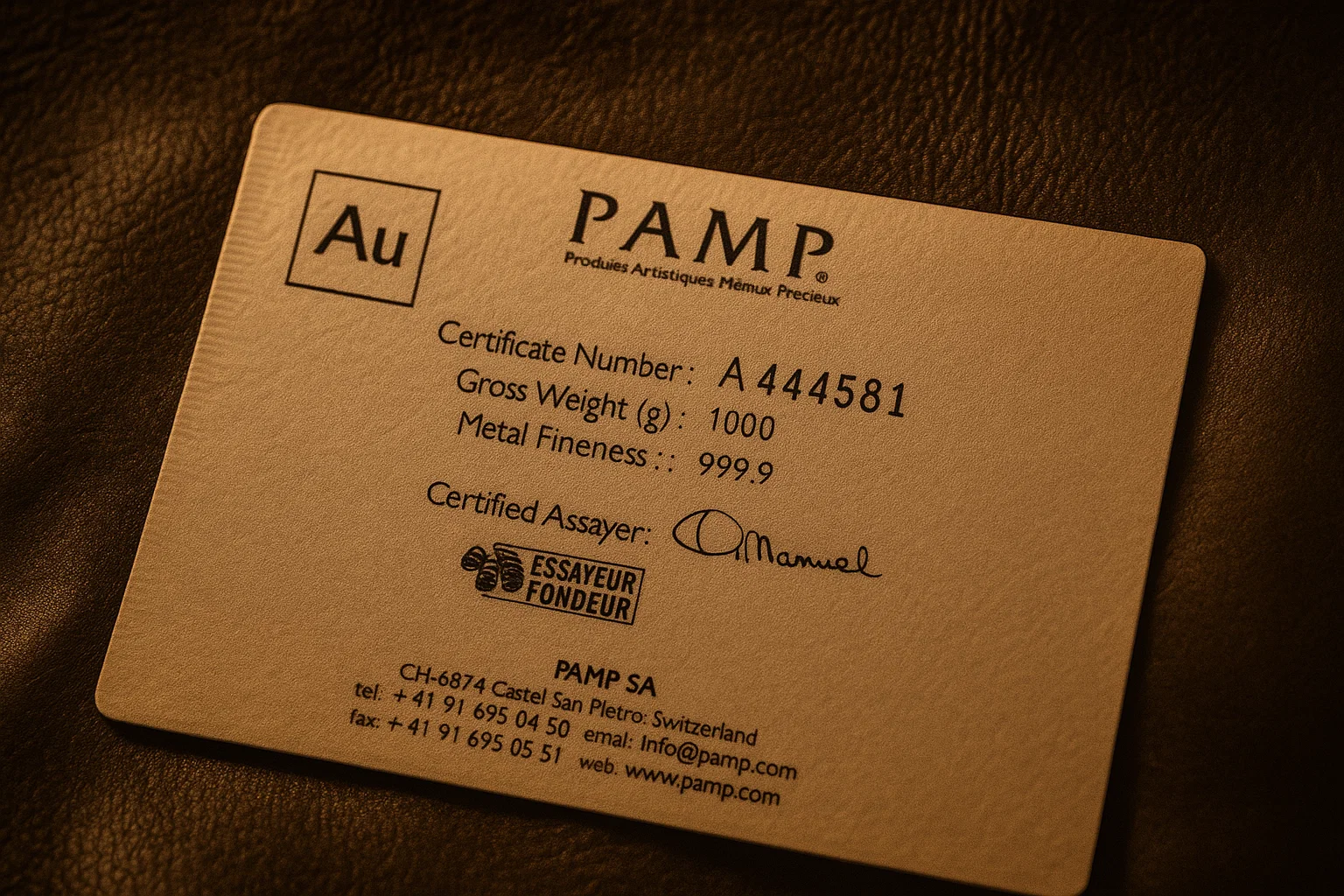It’s one of the smallest parts of your gold bar—but one of the most important.
If you’ve ever looked at a gold bar online and seen a sealed plastic case with a printed card, you’ve seen an assay certificate. It might look like packaging, but it’s actually one of your strongest protections as a buyer.
Let’s break down what it is, why it matters, and how to use it to your advantage.
What Is an Assay Certificate?
An assay certificate is a formal guarantee of the gold bar’s:
- Purity (e.g., .9999 fine gold)
- Weight (usually 1 troy ounce)
- Refiner or mint (like Asahi or PAMP)
- Unique serial number (if applicable)
It’s like a birth certificate for your gold—issued and sealed by the refiner itself. The assay card is usually built into the tamper-evident packaging around the bar.
Why It Matters
In a market where trust is everything, the assay certificate provides:
- Proof of origin and refinery standards
- Instant visual verification of authenticity
- Security—tamper-evident cases protect against fraud
- Resale support—dealers prefer bars with intact assays
💡 Pro Tip: If a gold bar is missing its assay card or has broken packaging, it may still be real—but its resale value and trust factor drop significantly.
What Does It Look Like?
Most assay cards include:
- The refiner’s logo (e.g., Asahi Refining)
- A certified assayer signature
- A barcode or serial number
- Sometimes a holographic seal or security feature
- The bar’s weight and purity
They’re often color-coded or branded depending on the refiner—but the key details remain the same.
Who Issues the Certificate?
Only trusted refiners like:
- Asahi Refining (formerly Johnson Matthey U.S.)
- PAMP Suisse
- Valcambi
- The Royal Canadian Mint
All of these operate under global good delivery standards—so the bars (and their assay certificates) are accepted by major vaults, dealers, and exchanges.
Do You Need It to Sell Your Gold?
Technically, no. But practically? Yes.
- Bars with assay are easier to verify and sell quickly
- Buyers (including dealers and IRA custodians) pay more for complete, certified bars
- Some platforms or IRA firms won’t accept bars without original packaging and certificate
In short: an assay-backed gold bar is a gold bar that travels well—with fewer questions and better resale confidence.
How to Store or Protect It
- Use soft storage like coin sleeves or boxes to avoid scratching the case
- Keep the packaging sealed—don’t remove the bar from its assay
- Avoid moisture, bending, or light exposure over time
Final Thought: It’s Not Just Packaging
The assay card is your proof. Your backup. Your trust signal. It’s one of the reasons Coins Online only sources gold bars from refiners that meet the highest global standards—so you’re not just buying gold, you’re buying confidence.
What An Assay Certificate Really Confirms
An assay certificate is the bar’s identity card. It confirms who refined it, what the bar weighs, how pure it is, and the unique serial that links the card to the metal inside the tamper-evident case. This simple card reduces questions at resale and helps collectors maintain clear records.
How To Read An Assay Card
- Refiner or mint name and logo
- Metal, weight, and fineness (for example .9999)
- Bar serial number that should match the number on the bar
- Authorized assayer signature or mark
- Tamper-evident case or seal
Collector Benefits Beyond Authentication
- Resale clarity: Dealers and fellow collectors can verify specs at a glance, which supports easier, faster transactions.
- Record keeping: Serial numbers simplify inventory logs, insurance documentation, and legacy planning.
- Condition preservation: A sealed case protects the bar’s surfaces from handling and environmental wear.
Practical Tips For Your Bars
- Keep bars sealed; do not remove them from the assay case unless testing requires it.
- Photograph both sides of the bar and the matching serial for your records.
- Store receipts and certificates together; consistent documentation strengthens trust.
- If a bar arrives with damaged or opened packaging, contact the seller before opening further and document with photos.
When Packaging Is Missing Or Damaged
A bar can still be genuine even if its packaging is compromised. However, resale may require additional verification (weight and dimension checks, XRF testing), and offers may be more conservative than for intact, sealed bars. Keeping the original, undamaged assay is the easiest way to preserve collector confidence.
Related Collector Resources
- Understanding Gold Purity and Hallmarks
- How to Spot Fake Gold
- How to Store Physical Gold Safely Home vs Vault Storage
- Gold Coins vs Gold Bars Whats Better for Beginners
Frequently Asked Questions About Assay Certificates
What is an assay certificate on a gold bar?
An assay certificate is the bar’s identity card. It lists the refiner, weight, fineness, and a serial number that matches the bar inside a tamper-evident case, providing fast, trusted verification.
What details should I check on the assay card?
Confirm the refiner name, metal, weight, fineness (e.g., .9999), and that the printed serial matches the number on the bar. Inspect the case for tamper-evident integrity.
Does a sealed assay case improve resale?
Yes. Sealed packaging with a matching serial simplifies verification for dealers and collectors, which can support smoother resale and trusted pricing.
Can a bar be real if the assay card is missing or damaged?
Yes, but it may require additional checks (weight, dimensions, and non-destructive testing). Bars with intact assays typically face fewer questions at resale.
Should I remove a bar from its assay packaging?
Avoid opening sealed packaging unless necessary for testing. Keeping the case intact preserves condition, protects surfaces, and maintains documentation continuity.
What if the serial on the card doesn’t match the bar?
Pause and document the mismatch with photos immediately. Contact the seller before proceeding—mismatched serials undermine the certificate’s value as proof.


Leave a Reply